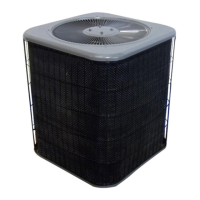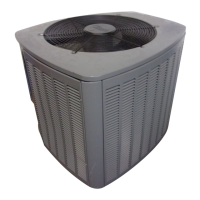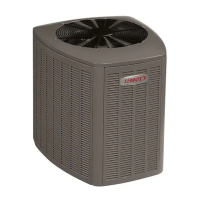Do you have a question about the Lennox 13ACX and is the answer not in the manual?
Identifies how to read the unit's serial number for model information.
Lists torque specifications for various fasteners used in HVAC components.
Explains how to use a manifold gauge set for system pressure checks.
Discusses factors for optimal unit positioning, including sound ordinances and windows.
Illustrates methods for isolating refrigerant lines to prevent vibration transmission.
Details installation practices for vertical refrigerant line runs.
Details installation practices for horizontal refrigerant line runs.
Provides steps for removing a fixed orifice metering device from an existing coil.
Provides steps for removing an expansion valve metering device from an existing coil.
Details how to connect necessary equipment for the flushing procedure.
Outlines the procedure for flushing refrigerant lines and the indoor unit coil.
Describes the process of installing an indoor expansion valve, including connections.
Explains the correct orientation and mounting of the sensing bulb for the expansion valve.
Details the installation procedure for the equalizer line connection.
Guides on connecting the manifold gauge set for leak testing the system.
Outlines the procedure for checking the system for refrigerant leaks.
Details connecting the gauge set for the evacuation procedure.
Explains the process of creating a vacuum in the refrigerant lines and indoor coil.
Specifies requirements for the 24VAC transformer used for control power.
Provides guidelines for installing the room thermostat, including location.
Describes the manual high pressure switch used on specific models.
Describes the automatic high pressure switch used on later models.
Outlines maintenance checks for the outdoor unit components and coils.
Instructions for cleaning and inspecting the outdoor coil.
Maintenance checks for the indoor unit, including filters and motors.
Maintenance steps for the indoor coil and connecting lines.
Describes the sequence of operations during the cooling cycle.
Explains the sequence when the cooling demand is satisfied.
Details how to check and adjust system airflow using the Delta-T process.
Describes the weigh-in method for charging the system with RFC or TXV.
Provides the method to calculate total refrigerant charge based on nameplate and line set length.
Explains using the weigh-in method for charging based on line length.
Details the TXV approach method for checking refrigerant charge.
Explains using the weigh-in method for charging based on line length.
Details the TXV subcooling method for checking refrigerant charge.
Explains using the weigh-in method for charging based on line length.
Details the RFC superheat method for checking refrigerant charge.
Guides on checking and adjusting system airflow for optimal performance.
Identifies how to read the unit's serial number for model information.
Lists torque specifications for various fasteners used in HVAC components.
Explains how to use a manifold gauge set for system pressure checks.
Discusses factors for optimal unit positioning, including sound ordinances and windows.
Illustrates methods for isolating refrigerant lines to prevent vibration transmission.
Details installation practices for vertical refrigerant line runs.
Details installation practices for horizontal refrigerant line runs.
Provides steps for removing a fixed orifice metering device from an existing coil.
Provides steps for removing an expansion valve metering device from an existing coil.
Details how to connect necessary equipment for the flushing procedure.
Outlines the procedure for flushing refrigerant lines and the indoor unit coil.
Describes the process of installing an indoor expansion valve, including connections.
Explains the correct orientation and mounting of the sensing bulb for the expansion valve.
Details the installation procedure for the equalizer line connection.
Guides on connecting the manifold gauge set for leak testing the system.
Outlines the procedure for checking the system for refrigerant leaks.
Details connecting the gauge set for the evacuation procedure.
Explains the process of creating a vacuum in the refrigerant lines and indoor coil.
Specifies requirements for the 24VAC transformer used for control power.
Provides guidelines for installing the room thermostat, including location.
Describes the manual high pressure switch used on specific models.
Describes the automatic high pressure switch used on later models.
Outlines maintenance checks for the outdoor unit components and coils.
Instructions for cleaning and inspecting the outdoor coil.
Maintenance checks for the indoor unit, including filters and motors.
Maintenance steps for the indoor coil and connecting lines.
Describes the sequence of operations during the cooling cycle.
Explains the sequence when the cooling demand is satisfied.
Details how to check and adjust system airflow using the Delta-T process.
Describes the weigh-in method for charging the system with RFC or TXV.
Provides the method to calculate total refrigerant charge based on nameplate and line set length.
Explains using the weigh-in method for charging based on line length.
Details the TXV approach method for checking refrigerant charge.
Explains using the weigh-in method for charging based on line length.
Details the TXV subcooling method for checking refrigerant charge.
Explains using the weigh-in method for charging based on line length.
Details the RFC superheat method for checking refrigerant charge.
Guides on checking and adjusting system airflow for optimal performance.
| Brand | Lennox |
|---|---|
| Model | 13ACX |
| Category | Air Conditioner |
| Language | English |












